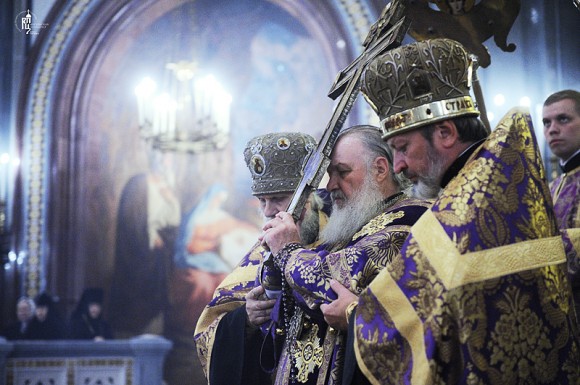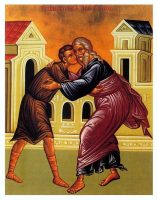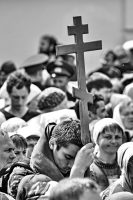The sayings of the prophets foretold the holy Wood, whereby Adam was set free from the ancient curse of death. And today, at the Exaltation of the Cross, all creation raises its voice, asking of God plenteous mercy. O Master, who alone art boundless in compassion, be our atonement and save our souls!’ (Troparion in Tone Six at the Veneration of the Cross)
Each year on the fourteenth of September (27th according to the Old Calendar) , just two short weeks after the Church begins her new liturgical year, the faithful come together in her temples for a unique celebration bound up in mystery and paradox. The yearly cycle of liturgical worship is again at its beginning, and in this season the Cross, that most horrible of tools, is hallowed in the centre of the church. The bishop, taking the adorned and decorated cross upon his head (or, if it be a large cross, upon his shoulders), processes to the centre of the temple where, as through it he presents his blessing, the people intone a solemn ‘Lord, have mercy’ no less than five hundred times.1
Yet this is not an occasion of sorrow. This day’s feast has a different tone than that of the last occasion on which the Cross stood so prominently in the middle of the people: Great and Holy Friday. Then, though the seed of an unquenchable joy already welled within us, the spirit which filled our souls was primarily one of sorrow and loss. But today, as the same Cross stands in our midst, the spirit is of invincible hope and glorious victory. ‘Hail, life-giving Cross! Hail, unconquerable trophy of godliness, door to Paradise, succour to the faithful, rampart set about the Church! Through thee corruption is utterly destroyed, the power of death is swallowed up, and we are raised from earth to heaven: invincible weapon, adversary of devils, glory of martyrs, true ornament of saints, haven of salvation bestowing on the world great mercy!’2 Perhaps the buoyant melody of Tone One never sounds so triumphant and joyful as when it proclaims the Troparion of this particular feast: ‘O Lord, save Thy people and bless Thine inheritance; granting victory to Orthodox Christians over their enemies, and guarding Thy commonwealth with Thy Cross!’3
On this great day, the precious Cross of Christ is not only venerated, it is exalted. It is elevated to the place of greatest honour, adored again and again as the ‘footstool’ by which Christ reigns over the universe.4 On this day, perhaps more than most other days, the full paradox of the Cross is loudly proclaimed: this instrument of most horrible death is become the ensign of victory and eternal life. The cruel weapon of torture and torment has been taken in the hand of God and transformed into the sword by which every enemy is defeated. The sword is raised, and the Devil is fallen. Without the Cross–nothing.
As the Feast approaches, one recalls, too, the full description of the day: on this occasion in mid-September, the Church commemorates not only the exaltation of the Cross (both as eternal reality and in memory of specific, historical occasions on which the True Cross was restored to the people); it commemorates the ”universal” exaltation of the Cross. Universal. ‘Catholic’. They are words that cause us to recognise the truly cosmic nature of this holy exaltation: everywhere, in all things, the Cross of Christ is proclaimed. As Saints and holy men have seen the Cross throughout nature, inscribed on all things, so does the psalmist tell us that even the fields exult and the trees of the forest sing for joy at their sanctification in the Saviour’s sacrifice.5 In all things, everywhere, the instrument of Christ’s victory is hallowed, proclaimed and exalted.
‘Universal’, though, applies to more than space. As the hymnography of the day makes abundantly clear, ‘universal’ applies equally to ”time”. The Cross which stood on Golgotha casts its shadow evermore into the future–into eternity itself. And in the mystery of the timelessness of God, the Cross also reaches back into the past, to the very beginnings of history and creation. Though the fullness of time has brought humanity the clearest revelation of the Cross through the reality of Christ’s crucifixion, witnessed by His disciples and the world, still there has never been a time when the world did not exalt this divine and precious Tree. From the beginning of the human economy, God made known to man the glory of things to come. Such revelation rings out in the holy Scriptures of the Old Testament, which, when read through the mind of the Church for whom they were given, offer countless glimpses of the might of the Cross. Texts in which our own darkened minds might find records of no great import, or perhaps of only historical significance, the Church proclaims through her Fathers as revealing abundantly the images and foreshadowings of the precious and life-giving Tree.
For the commencement of the ‘foretelling of the holy Wood’, one need look no further than the witness of those things which took place ‘in the beginning’, set down in the opening pages of Genesis. It is of no little significance that the one element of Paradise which had the power to lead to death was a tree (Gen 2.16, 17); yet it was not that the Tree of Knowledge was itself evil–St Justin the Martyr is certain that the tree is a symbol of Christ6–but that by lying about the tree the Devil might work his deception. ‘He who by a tree deceived our forefather Adam, is by the Cross himself deceived’.7 The hymns of the day leave no room for doubt, that the Evil One’s use of the tree to conquer man was itself a mystical prophecy of Christ’s future use of a Tree to defeat the Devil himself. The fact that humanity fell into death by eating from a tree is, say the Fathers, clear intimation that one day it might ‘find restoration in the wood of the Cross’.8
Holy Abraham’s near-sacrifice of his beloved son, Isaac (Gen 22.1-19), again intimates the future sacrifice of God’s only-begotten Son at Calvary. But not just the Passion is here foretold: the Cross itself is specifically prophesied–for as Isaac was led to the hilltop for sacrifice, he carried the wood of his torment upon his back (Gen 22.6). The image of Jesus ascending the rise to Golgotha with His Cross upon Simon’s shoulders (cf. Mark 15.21; Luke 23.26) is strikingly predicted. And we find in another life, that of the Patriarch Jacob, that near the point of his death, his actions, too, foreshadow the cross; for in offering the paternal blessing to Joseph’s sons, the figure of his own body, with his hands laid on their heads, is of a man extended upon a cross (Gen 48.14). In the person of Israel, it is from the figure of the Cross that the divine blessing comes to the children of God.
The sacred texts also provide imagery of a more specific character. The staffs of wood used to guide the Chosen People, as poignant examples, show forth the reality of the exalted power of the Cross. ‘Israel, foreseeing the future, did reverence the top of Joseph’s staff, revealing how in times to come the most glorious Cross should be the safeguard of royal power’.9 It was a staff of wood which signified the royal priesthood of Aaron (Numbers 17.1-8), and a wooden staff which the God-seer Moses used to part the very sea (Exodus 14.15-29). This entire segment of the Exodus from Egypt is itself a radiant icon of the spiritual life: for the holy people, before they could reach salvation from their pursuers, had to pass through the waters of the Red Sea–waters mystically prefiguring those of baptism. But before these waters could become the way to life, the power of the wood was required to call them into holy order. Is there a more meaningful image of the power of the Cross of Christ?
The Scriptures also foretell the extent of the power of the Cross: not only that it would have power, but that it would have cosmic power–power extending beyond the ‘natural laws’ of the universe. When Jonah, trapped in the belly of a whale, outstretched his hands in prayer and thus took upon himself the form of the cross, the sea-monster itself obeyed the divine command and expelled him safely onto dry land.10 And Joshua (whose name in Greek, lest we forget, is ”Jesus”), stopped the sun and the moon in their tracks by raising his hands crosswise and crying out to the Lord.11 How divinely fitting that this first Jesus would lead the Chosen People to victory through the shape of the cross, a clear foreshadowing of the eternal deliverance the heavenly Jesus would grant by that same figure.
The Scriptures disclose, too, that it would be through the Cross and the Cross alone that deliverance should come to humankind. When Moses bade Jesus the son of Nun to battle the forces of Amalek, the old prophet stood ‘on the top of a hill; and whenever Moses held up his hands [outstretched in the form of a cross], Israel prevailed. But whenever he lowered his hands, Amalek prevailed’ (Exodus 17.10, 11).12 As this first Jesus led God’s people to victory only in the shadow of the cross, so is the Cross of the eternal Jesus the one power of God for those who are being saved (1 Corinthians 1.18). As Justin memorably writes, ‘It was not because Moses prayed that the people were stronger, but because, while one who bore the name of Jesus was at the forefront of the battle, Moses himself made the sign of the Cross’.13 That the sacrifice of the Son upon the Cross would be the doorway to salvation is even mystically foretold in God’s instruction to Moses as to the design of the holy Sanctuary; for before one could obtain access to the Ark of the Covenant, the true dwelling place of the Holy One of Israel, he was required to pass by the table of oblation: the table of sacrifice (cf. Exodus 25.1-30). We should not be at all surprised to learn that this table was to be built, not of the stone usually required for sacrificial altars, but of wood.
We might well end here. Such examples are sufficient to show that the universality of the exaltation of the Cross extends fully into the beginnings of human history; that the divine tool of salvation was being mystically foretold in the lives and actions of the earliest members of the human family. But with all that has been said, we have still yet to come to the most poignant intimations of the holiness of the Cross of Christ. The Scriptures predict the power of the Cross, the regality of the Cross, the influence of the Cross; but they equally predict its sweetness and life-giving character. In the hymnography of the Feast, we hear time and time again of one Old Testament encounter in particular: The Israelites, in the midst of their wandering, find that their impatience has led them–as ours does us–into the deadly realm of sin. The poisonous venom of snakes was for them a living symbol of the death to which all sin leads; and surely by its power they were doomed. Yet salvation came, and came from God, and came upon a cross. ‘Moses set upon a wooden pole a cure against the deadly and poisonous bite of the serpents; for crosswise upon the wood–as a symbol of the Cross–he placed the serpent that creeps about the earth, and thereby triumphed over calamity’.14 In the sign of the Cross, Israel found life. The deadly venom of the serpent (and need we mention what evil force the serpent represents?) could not prevail against the power which came through the wood. The cross may be a device of torture, but from the beginning there were glimmers of its life-giving character.
And that which leads to life leads, as well, to the sweetness of God. When the Chosen People could not drink because the waters of the wilderness were too bitter, the Lord left them not to their suffering. Once again Moses, from whom we learn so much of the Saviour, turned to divine guidance. ‘He cried out to the Lord, and the Lord showed him a piece of wood. And when Moses threw the wood into the water, behold: the water became sweet’ (Exodus 15.25). As the Church sings triumphantly: ‘Not suffering the deadly bitterness of the tree still to remain, Thou hast utterly destroyed it through the Cross. In like manner of old did wood once destroy the bitterness of the waters of Marah, prefiguring the strength of the Cross that all the powers of heaven magnify’.15
The Cross in its power. The Cross in its glory. The Cross in its regality. The Cross in its sweetness. The Cross in its extent. The Cross in its majesty. All these are wondrously foretold in the pages of a testament we call Old and all too often think of as ‘outdated’ or ‘outmoded’. But when the Church sings her hymns, she sings of these stories; and when she magnifies the precious and life-giving Cross, she turns her eyes to these images. It is with a heart immersed in this truly cosmic and eternal universality of the Cross that she exults: ‘The Cross is the guardian of the whole earth! The Cross is the beauty of the Church! The Cross is the strength of kings! The Cross is the support of the faithful! The Cross is the glory of the angels and the wounder of demons! … We venerate Thy Cross, O Master, and we glorify Thy holy Resurrection!’.16
You might also like:
“Man Could Understand the Mystery of the Cross Only from Inside of His Human Nature” by His Holiness Kyrill, Patriarch of Moscow and All the Russia

















